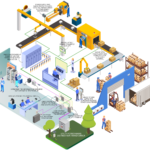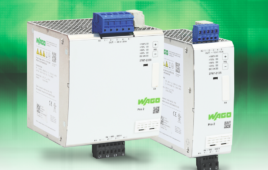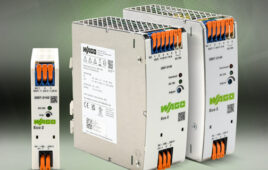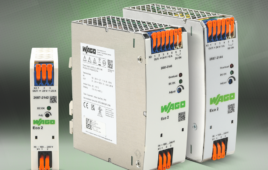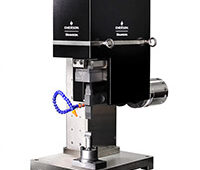Industrial electronics operate in electrically noisy and mechanically challenging environments. The problem is that automation, control, and instrumentation components rely on accurate signals sans electrical interference or distortion to properly operate. So optocoupler modules are often employed by engineers as signal-protecting intermediaries between signal sources as well as power sources and industrial controls and other components.
In industrial applications, an optocoupler module is a standalone DIN rail-mounted device imparting optical separation for a signal path. At its core is an optocoupler — a circuit featuring a light-emitting diode or LED and a photosensitive device. The optocoupler module’s input side includes power or signal-input electronics along with the LED. The output includes the photosensitive device (typically a phototransistor or photodiode) in an output circuit. When current passes through the LED, it causes the emission of infrared light that activates the photosensitive device — enabling current to pass through the optocoupler’s output. In this way, optocoupler output is akin to a digital switch that turns on and off in response to an input voltage-signal presence.

Optocouplers include an LED and photo-sensitive component. The LED or infrared light source on the input circuit communicates with a photosensitive semiconductor on the output side.
A key optocoupler parameter is the current transfer ratio or CTR, which is a measure of the ratio between the input and output current. While industrial controllers work sans optocouplers, the latter boost safety, reliability, and accuracy and avoid the potential issues of directly made (non-isolated) signal connections.
- Optocoupler modules prevent electrical interference: Everything from simple mechanical limit-switch signals to protocol-based data transmissions are susceptible to electrical noise in industrial environments. These signals are most vulnerable if they must travel any length of distance. Here, optocouplers can isolate common-mode noise arising from stray current flowing through ground connections. Properly setup systems using optocouplers for this purpose have the source and recipient circuits on separate ground and signal connections.
- Optocoupler modules connect high-voltage and low-voltage circuits: Industrial controllers can sustain damage if they’re fed input signals exceeding set limits … but often need to track power levels. For example, a PLC’s digital input might be designed to accept 24 Vdc — but need to monitor a 220-Vac load. Directly connecting the 220 Vac to the PLC input will obviously damage the latter. So here, an optocoupler module might accept the 220 Vac input and produce a feedback output voltage within the controller’s maximum allowable input.
- Optocoupler modules protect industrial controllers from transient events: Transient events are sudden short-lived voltage or current bursts. Despite their split-second duration, transients can cause major damage to industrial controllers. Here, optocoupler modules can serve as isolating barriers between the industrial controllers and any field sensors exposed to surges or inrush current.
Though optocoupler modules primarily isolate input signals and power sources, there are designs for which they help ensure the quality of output signals. For example, some optocoupler modules can replace electromechanical signal relays. The latter usually work off a low switching current of 2A or less. That makes optocouplers with similar or higher output current quite suitable replacements … but with far longer design life thanks to having no moving parts. More specifically, electromechanical relays usually work for 100,000 to 1,000,000 cycles … but optocoupler-based relays can last decades. What’s more, optocoupler modules avoid the electromechanical issues of back EMF and signal bounces.

The fast switching of optocoupler-based solid-state relays makes them suitable for use on myriad high-power system output loads. Optocouplers can also complement industrial power supplies with isolation.
High-speed switching optocouplers can also protect standard control and controlling power signals such as pulse-width modulation or PWM and Modbus RS485 — to give but two examples. Here the minimize coupling-based EMI coupling by isolating the controller and receiving component.
Using optocoupler modules for zero-crossing detection

Some ac-based applications need zero-crossing detection, which is a measurement of an ac signal’s transition as it switches above and below zero. Here, zero-crossing circuits can let controls measure the waveforms’ frequency and phase — and the narrow pulses formed at the output each time the ac signal crosses the 0-V point. Zero-crossing detector-circuit variations abound, but those based on optocouplers excel. Optocouplers offer a noise isolation barrier between the ac signal and controller … and many optocoupler modules even have built-in zero-detection circuits to reduce part count.
When optocouplers complement power supplies, it’s usually at the power supply’s feedback control loops to (along with an input-side transformer) isolate system dc/ac, ac/ac, ac/dc, or dc/dc converters. Such arrangements eliminate all direct conductive paths between the power input and all output terminals (and any attached field devices, motors, or other loads) for safer and more efficient designs. On equipment that regularly switches between drastically different power states, optocouplers can (even to dozens of kV/μsec) protect power supplies from transient common-mode voltages. On high-voltage applications, optocouplers can also break ground loop currents caused by disparate power supplies in a design having slight ground-potential differences — in turn eliminating common-mode electrical noise problems.
How to choose an optocoupler module
These are the top parameters that dictate the most suitable optocoupler module choice.
Input voltage — Determine the maximum voltage of the input signal and choose an optocoupler module that’s above the limit.
Output voltage and current — Ensure the optocoupler’s output can handle the voltage and current required by the application. Some optocoupler modules are built with high current or high-voltage output ratings.
Response time — Any optocoupler for high-speed signaling will necessitate a response time measured in microseconds (μsec).
Mounting — It’s possible to build optocoupler circuits from scratch, but DIN rail-mounted modules offer easy installation.
You may also like:
Filed Under: Power supplies



